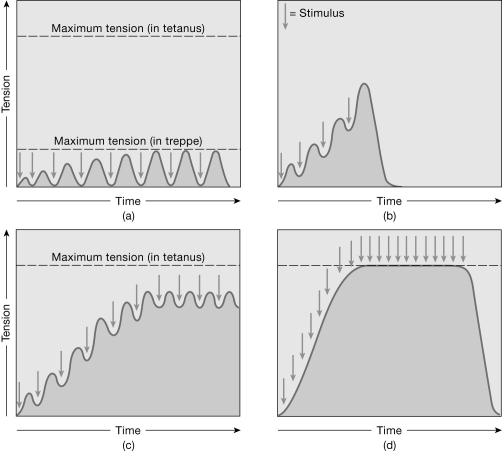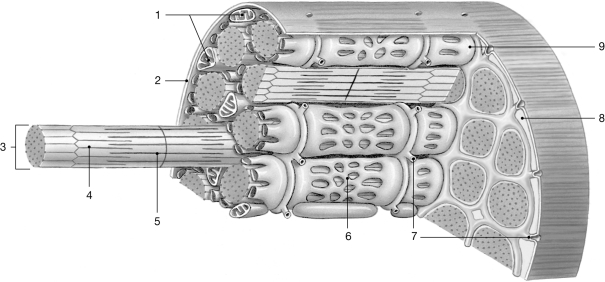A) the ability to store extra DNA for metabolism.
B) the ability to contract.
C) the ability to produce more ATP with little oxygen.
D) the ability to produce large amounts of the muscle proteins needed for growth and repair.
E) both C and D
Correct Answer

verified
Correct Answer
verified
True/False
A thin filament is constructed from actin, tropomyosin, troponin, and nebulin
Correct Answer

verified
Correct Answer
verified
Multiple Choice
Muscle fibers differ from "typical cells" in that muscle fibers
A) are very small.
B) lack mitochondria.
C) lack a plasma membrane.
D) have many nuclei.
E) both B and C
Correct Answer

verified
Correct Answer
verified
Multiple Choice
 Figure 9- 2 Muscle Contractions
Use Figure 9- 2 to answer the following questions:
-What is the contraction in graph d) called?
Figure 9- 2 Muscle Contractions
Use Figure 9- 2 to answer the following questions:
-What is the contraction in graph d) called?
A) wave summation
B) complete tetanus
C) incomplete tetanus
D) twitch
E) treppe
Correct Answer

verified
Correct Answer
verified
Multiple Choice
After heavy exercise, if energy reserves in a muscle are depleted, _________occurs.
A) an oxygen debt
B) tetanus
C) paralysis
D) atrophy
E) treppe
Correct Answer

verified
Correct Answer
verified
Multiple Choice
 Figure 9- 2 Muscle Contractions
Use Figure 9- 2 to answer the following questions:
-To produce a contraction similar to the one in graph b) , the muscle
Figure 9- 2 Muscle Contractions
Use Figure 9- 2 to answer the following questions:
-To produce a contraction similar to the one in graph b) , the muscle
A) must be stimulated to the point of fatigue.
B) gradually warms up.
C) must be stimulated again before it has relaxed from the previous stimulation.
D) is excited by a stimulus of increasing intensity.
E) is caused to produce isolated twitches.
Correct Answer

verified
Correct Answer
verified
Multiple Choice
 Figure 9- 1 Skeletal Muscle Fiber
Use Figure 9- 1 to answer the following questions:
-Which of the following are found in the structure labeled "3"?
Figure 9- 1 Skeletal Muscle Fiber
Use Figure 9- 1 to answer the following questions:
-Which of the following are found in the structure labeled "3"?
A) actin
B) tropomyosin
C) myosin
D) titin
E) all of the above
Correct Answer

verified
Correct Answer
verified
Multiple Choice
Muscular force can be adjusted to match different loads by
A) recruiting larger motor units.
B) varying the frequency of action potentials in motor neurons.
C) recruiting more motor units.
D) A, B, and C
E) None of the above-muscle contraction is all- or- none.
Correct Answer

verified
Correct Answer
verified
Multiple Choice
Which of the following statements is false?
A) Skeletal muscle contractions may be summated.
B) Cardiac muscle contractions cannot be summated.
C) Cardiac muscle stimulation is neural.
D) Skeletal muscle stimulation is neural.
E) Cardiocytes are interconnected through intercalated discs.
Correct Answer

verified
Correct Answer
verified
Multiple Choice
During the recovery period following exercise, all of the following are true, except
A) the muscle actively produces ATP.
B) heat is generated.
C) oxygen is consumed at above the resting rate.
D) lactic acid is removed from muscle cells.
E) muscle fibers are unable to contract.
Correct Answer

verified
Correct Answer
verified
Multiple Choice
Triggering of the muscle action potential occurs after
A) the nerve action potential jumps across the neuromuscular junction.
B) acetylcholine binds to chemically gated channels in the end plate membrane.
C) acetylcholinesterase binds to receptors on the end plate.
D) calcium ion binds to channels on the end plate.
E) Any of the above can produce an action potential in the muscle cell.
Correct Answer

verified
Correct Answer
verified
Multiple Choice
Muscle tissue, one of the four basic tissue groups, consists chiefly of cells that are highly specialized for
A) peristalsis.
B) contraction.
C) conduction.
D) cushioning.
E) any of the above
Correct Answer

verified
Correct Answer
verified
Showing 121 - 132 of 132
Related Exams